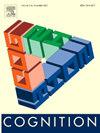The effect of orthography on the visual processing of affixed words: Evidence from Bengali
IF 2.8
1区 心理学
Q1 PSYCHOLOGY, EXPERIMENTAL
引用次数: 0
Abstract
The view that morphologically complex words are decomposed into constituent morphemes during lexical access has gained traction in the psycholinguistic literature, which in turn has had significant implications for theories of lexical organisation and processing. Nevertheless, the bulk of evidence for how morphologically complex Indo-European words are accessed and stored is based on based on Latinate scripts, where the orthography tends to be sequential. In many languages however, it is not straightforward to determine the internal structure of the word from the script alone. To critically examine the morphological decomposition in the visual domain, we present results from a visual delayed priming study covering every possible combination of morphologically complex words (i.e. stem ∼ prefixed, stem ∼ suffixed, prefixed – prefixed, suffixed – suffixed, and prefixed ∼ suffixed) in Bengali, a language rich with derivational morphology and orthographic complexity.
Results for configurations containing stems (stem ∼ affixed) showed the only priming effects in the study; crucially, these findings depended heavily on whether the prime was a stem or affixed word. When the prime was a stem word, responses to both prefixed and suffixed targets were facilitated to a similar degree. When the primes consisted of affixed words (either prefixed or suffixed), they did not reliably prime stem targets. We also tested relationships between all affixed words and found no reliable priming effect for any combination. We argue that our results reflect not only modality-specific aspects of processing, but also asymmetries in the orthographic significance of phonological processes occurring at the stem-affix boundaries in Bengali.
正字法对贴字视觉加工的影响:来自孟加拉语的证据
词形复杂的词在词汇获取过程中被分解为组成语素的观点在心理语言学文献中得到了广泛的关注,这对词汇组织和加工理论具有重要意义。然而,关于如何访问和存储形态复杂的印欧单词的大量证据是基于拉丁文字的,而拉丁文字的正字法往往是顺序的。然而,在许多语言中,仅从文字来确定单词的内部结构并不简单。为了严格检查视觉领域的形态学分解,我们提出了一项视觉延迟启动研究的结果,该研究涵盖了孟加拉语中所有可能的形态学复杂单词组合(即词干~前缀、词干~后缀、前缀-前缀、后缀-后缀和前缀~后缀),这是一种富含衍生词法和正字法复杂性的语言。在研究中,包含茎(茎~贴)的配置结果显示了唯一的启动效应;至关重要的是,这些发现在很大程度上取决于启动词是词干还是附加词。当启动词是一个干词时,对带前缀和后缀的目标的反应都有相似的促进程度。当启动词由固定词(前缀或后缀)组成时,它们不能可靠地启动干目标。我们还测试了所有附加词之间的关系,发现任何组合都没有可靠的启动效应。我们认为,我们的结果不仅反映了加工的特定情态方面,而且反映了在孟加拉语词干-词缀边界发生的语音过程的正字法意义的不对称性。
本文章由计算机程序翻译,如有差异,请以英文原文为准。
求助全文
约1分钟内获得全文
求助全文
来源期刊

Cognition
PSYCHOLOGY, EXPERIMENTAL-
CiteScore
6.40
自引率
5.90%
发文量
283
期刊介绍:
Cognition is an international journal that publishes theoretical and experimental papers on the study of the mind. It covers a wide variety of subjects concerning all the different aspects of cognition, ranging from biological and experimental studies to formal analysis. Contributions from the fields of psychology, neuroscience, linguistics, computer science, mathematics, ethology and philosophy are welcome in this journal provided that they have some bearing on the functioning of the mind. In addition, the journal serves as a forum for discussion of social and political aspects of cognitive science.
 求助内容:
求助内容: 应助结果提醒方式:
应助结果提醒方式:


